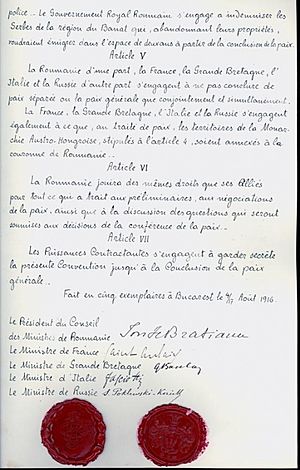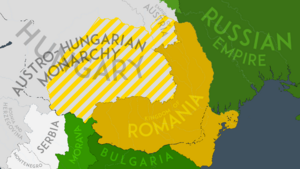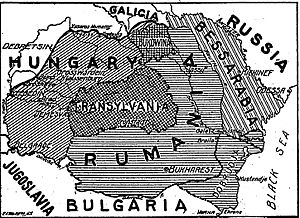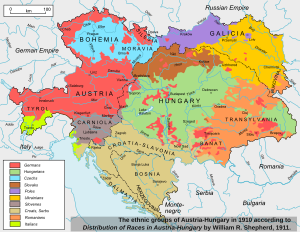Treaty of Bucharest (1916) facts for kids

Treaty of Bucharest (1916)
|
|
| Signed | 4/17 August 1916 |
|---|---|
| Location | Bucharest |
| Condition | Ratification by Romania and the Entente Powers |
| Signatories | |
| Languages | French |
The Treaty of Bucharest of 1916 was an important agreement signed during World War I. It was made between Romania and a group of countries called the Entente Powers. These powers included Russia, France, Great Britain, and Italy.
The treaty was signed on August 17, 1916, in Bucharest, the capital of Romania. It set out the rules for Romania to join the war on the side of the Entente. A big part of the agreement involved promises of land for Romania from Austria-Hungary. The countries involved agreed to keep the details of this treaty a secret until the war ended.
Contents
Why Romania Joined the War
In 1915, a British officer named Christopher Thomson went to Bucharest. His job was to convince Romania to join the war with the Allies. Thomson, who spoke French well, thought Romania was not ready for war. He believed Romania would be a problem for the Allies, not a help. This was because Romania was not well-armed and would have to fight on three sides.
However, his bosses in Britain did not agree with him. So, Thomson signed a military agreement with Romania on August 13, 1916. He felt worried about it, but he did his job. After this, he became the leader of the British Military Mission in Romania.
What the Treaty Said
The Treaty of Bucharest had two main parts. One part was a political treaty with seven articles. The other was a military agreement with seventeen articles.
The political treaty said that Romania had to declare war on Austria-Hungary by August 28, 1916. In return, Romania was promised several new territories. These lands were mostly controlled by Austria-Hungary at the time.
New Lands for Romania
The treaty promised Romania these areas:
- Transylvania, Crișana, and Maramureș: These lands were ruled by Hungary. Most people living there were Romanian. There were also Hungarian and German minorities. The new border would reach the Tisza river.
- The whole Banat area: This region was also ruled by Hungary. It had a mix of Romanians, Germans, Serbs, and Hungarians.
- Most of Bukovina: This land was ruled by Austria. Most people there were Romanian. Romania would get all of it except the part on the left bank of the Prut river.
The treaty also described the exact new borders for Romania. It said Romania would not build forts across from Belgrade, a city in Serbia. Romania also agreed to pay Serbs from Banat for their land if they moved away within two years.
Secret Promises and Guarantees
In the political part of the treaty, all countries promised not to make a separate peace. This meant they would not stop fighting alone. Great Britain, France, Italy, and Russia also promised that Romania would get the new territories when a peace treaty was signed.
The Entente Powers also guaranteed that Romania would have equal rights at the future Peace Conference. This meant Romania would have a say in how the war ended. All countries agreed to keep the treaty a secret until a general peace was signed.
Military Plans
The military part of the treaty had specific plans. Romania was to attack Austria-Hungary from the south. At the same time, Russia promised to start an attack on the Austrian front. This would help Romania's advance into Transylvania.
Russia also promised to send two groups of soldiers and one group of cavalry to Dobruja. This was to protect Romania's back from an attack by Bulgaria. France and Britain promised to start an attack on the Thessaloniki front. Their goal was to make Bulgaria leave the war.
Romania's Role in World War I
On August 27, 1916, King Ferdinand of Romania held a meeting. They decided to honor the treaty with the Entente Powers. That same day, Romania declared war on Austria-Hungary. Three Romanian armies, with 440,000 soldiers, crossed the Southern and Eastern Carpathians mountains that night.
At first, the Romanian Army advanced easily. Austria-Hungary did not have many soldiers along the border. But by mid-September, the attack stopped. Soldiers from Germany, Bulgaria, and the Ottoman Empire moved into Dobruja. This threatened to surround the Romanian Army from the southeast.
By October, the Romanian Army was pushed out of Transylvania. German soldiers helped with this. By the end of 1916, Romania's capital, Bucharest, had fallen. Much of Romania, including Wallachia and Dobruja, was controlled by the Central Powers. The Romanian government moved to Iași. Christopher Thomson, who was leading the British Military Mission, had to deal with Romania's defeat. He personally made sure Romanian oil wells were destroyed so Germany could not use them.
In 1917, the Romanian Army got stronger. They managed to stop German attempts to break their front line. This happened even though the Russian Army was falling apart after the February Revolution. Russia left the war in March 1918 with the Treaty of Brest-Litovsk. This left Romania alone in Eastern Europe.
A peace treaty between Romania and the Central Powers (Treaty of Bucharest (1918)) was discussed in May 1918. However, Romania did not officially agree to it. This allowed Romania to declare war on the Central Powers again on November 10, 1918. Because of this, Romania was able to join the peace talks as a winning country.
About 220,000 Romanian soldiers died in the war. But in the end, Romania gained Transylvania, two-thirds of the Banat, Bukovina, and Bessarabia through the Treaty of Trianon.
Images for kids










